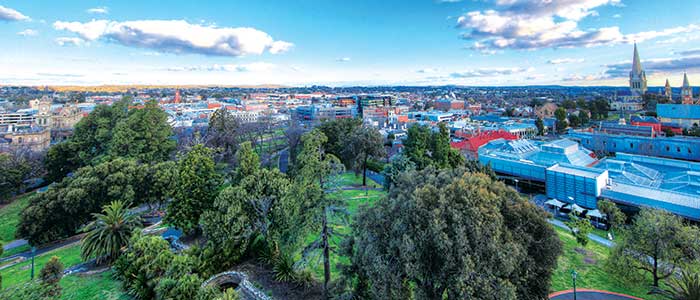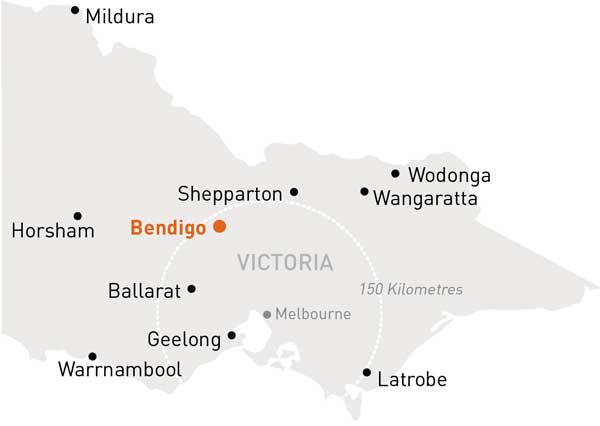
A thriving and productive city with a unique historical connection to China
| Local Government Area (LGA) | City of Greater Bendigo |
| Neighbouring Local Government Areas | Loddon, Campaspe, Mount Alexander, Strathbogie, Mitchell |
| LGA Population, 2020 | 130,000 |
| Estimated Population, 2036 | 153,800 |
| Population Growth between 2015-2020 | 1.8% per annum |
| Forecast Population Growth | 1.6% per annum from 2016 to 2036 |
| Output | $6.1 billion Gross Regional Product |

Bendigo is one of regional Victoria’s most progressive and contemporary cities and is located in the heart of the Goldfields region. It is the principal service centre for the Loddon Mallee, Loddon Campaspe region and the city’s key industries include mining and financial services.
Situated about 150km northwest of Melbourne, it is the third-most populous city in regional Victoria and an important city for the central Victorian economy.
Bendigo is an important tourist city in Victoria, with a trove of gold rush era architecture and numerous cultural festivals, including those celebrating Bendigo’s large Chinese community, such as the annual Chinese New Year celebrations.
Bendigo comprises suburban communities based around key transport corridors. Bendigo has established itself as a manufacturing base for primary industries operating in the region. In recent decades, the city has specialised in finance and insurance services, health care and education.
Culture and lifestyle
Bendigo is renowned for its arts and culture. The Bendigo Art Gallery, located in the View Street Arts Precinct, is one of the best and largest galleries in regional Australia. It is home to one of the most outstanding permanent collections of 19th Century European and Australian art in the country and is well known for exclusive international exhibitions.
Next door to the gallery is the Capital Theatre, Bendigo’s performing arts centre. Built in the 1870s and converted to its present use in the 1980s, the Capital features local and international theatre, music, comedy and dance acts. A recent addition to Bendigo’s cultural facilities is the Ulumbarra Theatre, rising from within the walls of the historic Sandhurst Gaol.
With its two award-winning wine regions, Heathcote and Bendigo, the city is widely regarded for its excellent wine and food culture. Wonderful local food is showcased on the menus of the city’s restaurants, bars and cafes that proudly support the region’s farmers, suppliers and wineries.
Employment, industry and infrastructure
Bendigo has approximately 8,255 businesses and a workforce of around 53,533 people.
Health Care and Social Assistance is the primary employment industry in Greater Bendigo, followed by Retail Trade, Construction, Manufacturing and Education and Training. In the five-year period 2015-2020, there was strong employment growth in Health Care and Social Assistance, Other Services, Retail Trade and Agriculture, Forestry and Fishing.
In terms of Gross Value Added activity, Financial and Insurance Services is the largest performing sector in Greater Bendigo, generating $797 million in 2020. Health Care and Social Assistance, Manufacturing and Construction are also key industry sectors.
The city is is connected to Melbourne and other regions by high-quality road and rail infrastructure. As the largest regional centre in the Loddon Mallee region, the city is expected to experience a relatively high growth rate compared to other parts of the region and regional Victoria as a whole.
| Major Businesses | Industry |
|---|---|
| Bendigo Bank | Banking |
| Rural Finance Corporation | Financial and insurance services |
| Thales | Defence |
| Hofmann Engineering | Primary and fabricated metal product manufacturing |
| Keech Castings | Primary metal product manufacturing (steel castings) |
| Parmalat | Dairy product manufacturing |
| Hazeldene’s Chickens | Meat product manufacturing (poultry) |
| Bendigo Health | Health care and social assistance |
|
La Trobe University, Bendigo TAFE | Tertiary education |
